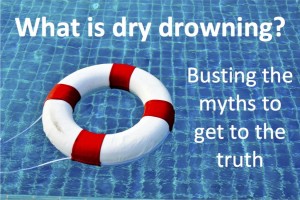 Most people would say that “dry” drowning occurs hours or even days after an individual experiences respiratory impairment from submersion. Drowning is the process of experiencing respiratory impairment from submersion/immersion in a liquid. If someone has difficulty breathing as a result of being underwater, then they have drowned. Therefore, there are only two outcomes in drowning:
Most people would say that “dry” drowning occurs hours or even days after an individual experiences respiratory impairment from submersion. Drowning is the process of experiencing respiratory impairment from submersion/immersion in a liquid. If someone has difficulty breathing as a result of being underwater, then they have drowned. Therefore, there are only two outcomes in drowning:
- Non-Fatal Drowning – The process of drowning is interrupted and the individual survives.
- Fatal Drowning – The drowning process is NOT interrupted and the individual dies, however this does not have to be immediate.
Drowning doesn’t always end in death. Thousands of people, adults and children, drown every year and survive without any additional complications. There are also a significant number of people who suffer non-fatal drowning and as a result have severe, moderate, or mild brain damage. You can think of this situation as similar to that of heart attacks or strokes. Some people who experience a heart attack will die, some will survive without complications, and some will survive with some amount of complications. The same is true with drowning.
Any person – adult or child – who has been in or under the water and has symptoms of difficulty breathing, excessive cough, foam or froth in the mouth, or are not acting right immediately or within a few hours of being in the water is said to have had a non-fatal drowning and should seek care from a doctor. Symptoms usually appear immediately, but may be delayed by a few hours or get progressively worse. Onset or worsening of symptoms usually occurs within the first 8 hours of submersion.
There is no such thing as “dry,” “wet,” “delayed,” or “secondary” drowning. Anyone with respiratory impairment, not acting right, excessive cough, foam, or lethargy after being underwater, even briefly, should be taken to a hospital for further evaluation. Drowning is a spectrum ranging from mild to moderate to severe.
There is no such thing as “near” drowning. A person who does not die from a drowning incident has suffered a non-fatal drowning and survives with either no complications or brain or other organ damage ranging from mild, to moderate to severe.
One of the reasons it is so important that we (parents, doctors, researchers, lifeguard trainers, EMS, aquatic safety organizations and the media) speak the same language so that we can better understand the scope of the drowning problem and better prevent and treat it.
The best way to prevent drowning is by remember three key elements of water safety.
- Supervision – Children and adults should always be supervised by a non-distracted adult. The Water Watcher should not be talking to others, using a phone, or have any other responsibilities other than watching the water. The Water Watcher should also be trained in CPR and first aid.
- Barriers – All pools should have properly working barriers, including self-latching gates and doors. Never leave toys or items laying around the pool deck, as it can be enticing to children.
- Swimming Lessons – A study conducted by the National Institute of Health reveals that participating in formal swimming lessons is associated with an 88% reduction in the risk of drowning in children aged 1 to 4 years (Archives Pediatric Medicine, Vol 163 No 3, March 2009). Putting children in swimming lessons when they are young and keeping them enrolled until they are proficient swimmers will reduce the risk of drowning.
We believe that it is possible to Stop Drowning Now, but in order to do that we all have to work towards the same goals! Contact us for information on water safety and swimming lessons.